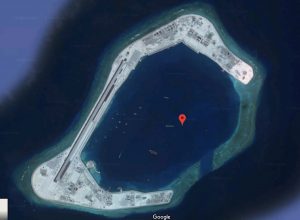
We do not know exactly how many billions because China is not a transparent liberal democracy with independent Budget accountability, but any number of Google Earth photographs reveal extensive work.
It stands to reason, that China is not going to let this go to waste. And as China goes about its business of spreading its influence in Pacific island nations through aid bribery, it is going to get a very clear message. That message is that climate-change induced rising sea levels pose an existential threat to these islands and of all issues, it is the most important for them.
China will then tweak. The very same rising sea levels that threaten Tuvalu, Kiribati and other island states will also threaten the billions of dollars worth of work they have done on the atolls in the South China Sea.
Moreover, under present UN Convention on the Law of Sea not only will the physical infrastructure be lost as the atolls go under, but also all the attendant fishing, mineral and sea and airspace rites that go with them.
The trouble is that the 1982 codification of the law of the sea, the maritime zones are measured from baselines. The baselines are straightened out where a coastline has a lot of indentations, bays and estuaries. But more importantly the baselines are “ambulatory”, that is like a walking human, capable of moving if the coastline moves for whatever reason.
It cuts both ways. For example, the creation of an island by volcanic activity in Iceland would create an extension to Iceland’s territorial, fishing, mining and economic zones. Similarly an Hawaiian lava flow would push out the maritime zones. On the other hand, if an island disappears the economic zone goes with it.
Perhaps, the convention could be renegotiated to fix the zones. But the original treaty took a decade to negotiate, so it might be too late, especially in the western Pacific where the sea-level rise has been three times the global average since 1998.
It seems very tough on these nations, given they did not cause the problem.
It may be of course, that China’s build up of atolls and reefs in the South China Sea was not only for military reasons, but also to protect them from rising sea levels.
Even so, they remain vulnerable and are an incentive for China to reduce the emissions that cause the climate change that is causing rising sea levels. They are also an incentive for China to ensure that other nations do their fair share to reduce emissions.
It may well be that China will impose trade penalties for those that do not, just as Europe is doing.
It is yet another reason for Australia to take more aggressive emissions-reduction action.
In any event, reducing emissions is not the burden initially thought. It makes good economic sense to reduce emissions, especially in electricity and transport. Once the upfront costs are met, it is all gain. Ask the 70-year-old woman who drove her electric car around Australia for a total recharge cost of $150.
The economic cost of not reducing emissions, aside from climate change, make action more sensible than inaction.
There is another reason. If nothing is done will probably be down to Australia to rescue islanders who, unlike people in bigger landmasses, will have nowhere else to go.
00000000000000
Last week, I mentioned the increasing possibility of hung Parliaments as more minor-party candidates and independents get elected as the primary vote of the major parties falls below a critical level.
I wrote that with the falling major-party vote in an increasing number of seats it will be possible for the minor parties to harvest preferences so that the last minor-party or independent left standing would be ahead of the worse major-party candidate and pick up their preferences to beat the other major-party candidate.
That very evening the votes were counted in the Wagga by-election in NSW. The Liberal vote did not merely fall. It collapsed by 28 percentage points to just 25.5 per cent. On the primary vote an independent, Joe McGirr, got 24.5 per cent ahead of Labor on 23.7.
At the time of writing, the count was not finished, but both major parties have conceded the seat. McGirr is likely to pick up most of the preferences of other minor-party and independent candidates, who together got 25 percent , to stay ahead of Labor and then take Labor preferences to beat the Liberal candidate.
And this was in NSW where preferential voting is optional. Voters are instructed to put at least a 1 against one candidate. Many voters do not go beyond that. Federally, voters are instructed to number every candidate in order of preference. That makes it easier for the minor-party or independent to come through the middle.
Of course, there were a number of other factors in Wagga: the disgrace of the outgoing Liberal; the failure of the Nationals to stand; the likeability of the successful independent and so on.
Nonetheless, without the overall falling vote for the major parties, there would be less room for an independent to get through the middle.
The other factor which will make hung parliaments more likely is that once a minor-party candidate or independent gets in, they tend to get re-elected, often with an increased vote.
Centre Alliance’s Rebekha Sharkie proved this in the Mayo by-election when she increased her primary vote by 9 percentage points to 44 per cent.
It means that at the next election, the starting point will be the existing five minor-party and independent MPs with only more to come and majority government less likely.
CRISPIN HULL
This article first appeared in The Canberra Times and other Fairfax Media on 15 September 2018.